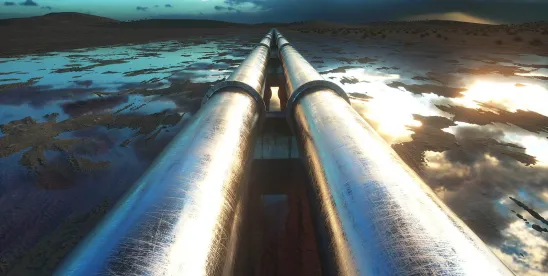On October 10, 2025, Governor Newsom signed SB 614 into law, which establishes a pathway to lifting the current moratorium on use of intrastate carbon dioxide (CO2) pipelines in California in connection with CO2 capture, removal, or sequestration (CCRS) projects. The new law also directs the Office of the State Fire Marshal (OSFM) to adopt regulations governing CO2 pipeline transportation in California by July 1, 2026, that are at least as protective as the regulations proposed and issued in only pre-publication form earlier this year by the federal Pipeline and Hazardous Safety Administration (PHMSA). The enactment of a pathway for lifting the current moratorium on CO2 pipeline transportation, at least for intrastate pipelines, is a key development for the advancement of CCRS projects in California, which are necessary for the state to meet its climate change mitigation goals.
Prior to the enactment of SB 614, California law prohibited all in-state pipeline transportation of CO2 related to CCRS projects until PHMSA concluded its ongoing rulemaking to enhance federal pipeline safety standards to address the increasing use of pipelines for CO2 transportation in connection with carbon capture, use, and sequestration projects. See Cal. Pub Res. Code 71465(a) (2025). PHMSA issued its Notice of Proposed Rulemaking (NPRM) with proposed revisions to the federal pipeline safety regulations in early January 2025 before the change of administration; but the NPRM was withheld from publication in the Federal Register, in accordance with the “regulatory freeze” memorandum issued on the first day of the current presidential administration. It is unclear whether PHMSA will pick back up the NPRM process and finalize its CO2 pipeline rulemaking. This effectively left the California moratorium on CO2 pipelines in place indefinitely.
SB 614 changes the status quo by directing OSFM to adopt state CO2 pipeline safety regulations that are at least as protective as the standards set forth in PHMSA’s unpublished NPRM, setting a July 1, 2026 deadline for OSFM to do so and authorizing the use of truncated emergency rulemaking procedures. Once OSFM has completed this process, the statewide moratorium as to intrastate CO2 pipelines used in connection with CCRS projects is lifted, so long as the CCRS project operator can demonstrate that its pipeline meets the standards in the OSFM regulations (with a very limited exception for “carbon captured at a permitted facility and transported within that facility or property”). The pre-existing moratorium on CO2 pipeline transportation associated with CCRS pipelines remains in place under SB 614 with respect to interstate pipelines until PHMSA completes its rulemaking process initiated with the unpublished NPRM.
Additionally, SB 614 provides much-needed clarification in the Elder California Pipeline Safety Act of 1981 as to the scope of OSFM jurisdiction over intrastate CO2 pipelines—by revising the definition of “pipeline” throughout the Act to include intrastate pipelines used for the transportation of CO2.
Among other actions, SB 614 also:
Vests exclusive safety regulatory and enforcement authority over intrastate CO2 pipelines with OSFM.
Requires OSFM to develop regulations by July 1, 2026, that at minimum meet the standards proposed by the draft regulations issued by PHMSA on January 10, 2025.
Prohibits pipelines or pipe components that were originally constructed to transport any other liquid or gas from transporting CO2.
Requires OSFM, at least once every five years, to assess the safety standards and amend its regulations, as appropriate.
Authorizes OSFM to order the shutdown of a CO2 pipeline for violations of law or if the continued operation of a pipeline presents an immediate danger to health, welfare, or the environment.
Authorizes OSFM to conduct enforcement proceedings and impose civil penalties for violations of applicable law or regulation.
With the enactment of SB 614, California joins a growing number of states establishing regulatory frameworks to facilitate and oversee pipeline transportation of CO2. These state-level regulatory developments come in the absence of comparable federal initiatives, with the finalization status of PHMSA’s updated safety regulations remaining uncertain and a legislative proposal to provide the Federal Energy Regulatory Commission with siting authority over CO2 pipelines failing to make it into the final One Big Beautiful Bill Act.
Clare Ellis and Nathan R. Menard contributed to this article

